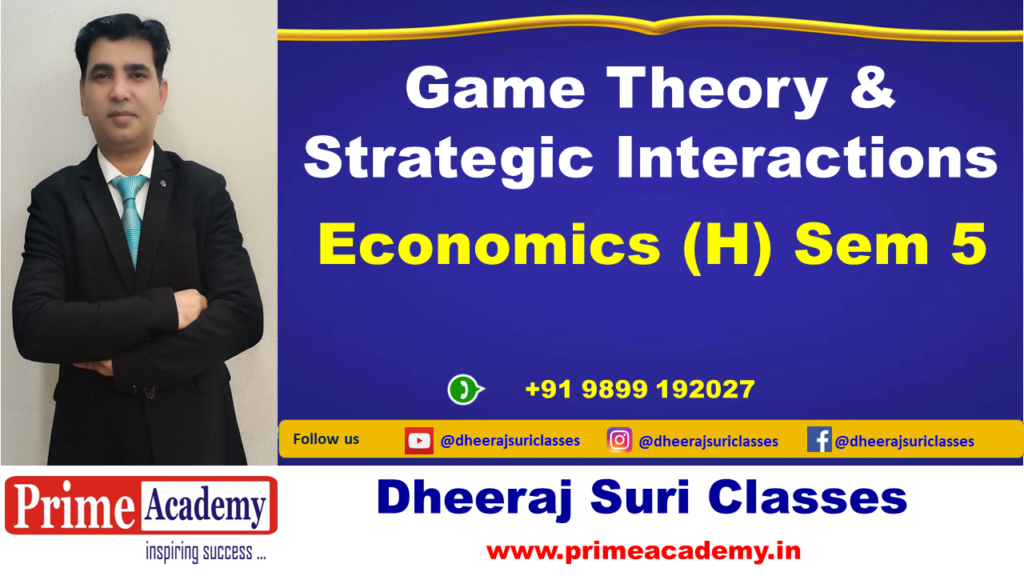Welcome to Prime Academy
We provide Best Online Coaching for Game Theory and Strategic Interactions [ECON 013] for Economics (H) Semester V, University of Delhi
For getting access of recorded video lectures of
Game Theory and Strategic Interactions [ECON 013] for Economics (H) Semester V
you need to subscribe our course.
If you are not registered at our website then Register Here (After registration please inform us at +91 9899 192027 to get the access)
If you are already registered and have Got the access then Login to watch the Lectures
The Game Theory and Strategic Interactions [ECON 013] Course for BA (Hons) Economics Semester V, Delhi University has been taught by Mr. Dheeraj Suri. The Video Lectures are based upon the books prescribed by the University of Delhi. The Duration of Video Lectures is approximately 55 Hours.
Access of Video Lectures is provided on any one of the following devices:
Windows Computer or Laptop, or
Android Phone or Tablet, or
Apple Iphone or Ipad, or
Apple Macbook,
till end of Semester V Exams.
Course Fee : Rs. 7000
Fee Structure :
| Single Device | Two Devices | |
|---|---|---|
| Single Subject | Rs. 7000 | Rs. 12,000 |
| Two Subjects | Rs. 13,500 | Rs. 23,000 |
| Three Subjects | Rs. 20,000 | Rs. 33,000 |
| Four Subjects | Rs. 26,000 | Rs. 42,000 |
Once You get the access you need to login and download our APP and all the lectures from your login account and play in your device.
You will get :
►Full Course Video Lectures
►Video Lectures Cover Theory Portions Exhaustively + Complete Solutions of Back Questions of Readings + Solutions of Previous Years Papers + Large Number of Numericals
►Complete Study Material (PDF Notes) which includes Concepts, Previous Year Questions, Numerical Questions, MCQ’s and Important Questions
►Live Online Doubts Sessions with Expert Faculty (at least twice a week) for resolution of Doubts
►Online Discussion Forum to Post Your Queries to Discuss with Faculty & other fellow Students
►Mock Tests at the Website for regular assessment and progress tracking
►Comprehensive Coverage of Syllabus and Exam Oriented Preperation
This online coaching platform aims to provide a supportive and engaging learning environment for students to achieve academic success and excel in their Economics Honours program.
Demo Lectures for Game Theory & Strategic Interactions
Course Introduction
Game Theory Introduction
Chapter 1 : Nash Equilibrium
These Lectures are Only for Demo.
For Complete Course Video Lectures You Need to Subscribe Our Course
Contact us at +91 9899192027 for details
Demo Quiz
For Complete Mock Test Series of Game Theory & Strategic Interactions, You need to subscribe our course.
Contact us at +91 9899192027
Demo PDF Notes
Demo PDF of Study Material for Game Theory & Strategic Interactions
Chapter-2-Mixed-StrategyClick Here to Download Demo PDF of Study Material
For Complete PDF Notes of Game Theory & Strategic Interactions
Contact us at +91 9899192027
Exam Pattern for Game Theory & Strategic Interactions
The Question Paper will be of 90 Marks
►All units carry equal weightage
►Internal Assessment 30 Marks
►Continuous Assessment 40 Marks
Recommended Readings
►Osborne, M. (2004) : An Introduction to Game Theory (Indian Edition)
►Watson, J. (2013): Strategy: An Introduction to Game Theory, 3rd edition
Course Content of our Video Lectures
Lectures are Strictly as per Latest Syllabus for UGCF 2024
Chapter 0 : Game Theory Introduction
Number Video Lectures : 2
Duration of Video Lectures : 90 Minutes
Topics Covered
►Game Theory Introduction,
►Key Terminologies ,
►Types of Games,
►Representation of Games,
►Nash Equilibrium,
Unit I : Complete Information Simultaneous Move Game
Chapter 1 : Nash Equilibria
Number Video Lectures : 4
Duration of Video Lectures : 60 Minutes
Based Upon Chapter 2 Osborne
Topics Covered
►Strategic Games,
►Examples : Prisoner’s Dilemma, Bach or Stravinsky, Matching Pennies, The Stag Hunt ,
►Nash Equilibrium,
►Best Response Functions,
►Dominated Actions,
Chapter 2 : Mixed Strategies
Number Video Lectures : 2
Duration of Video Lectures : 60 Minutes
Based Upon Chapter 4 & Chapter 11 Watson
Topics Covered
►Notion of Mixed Strategy,
►Mixed Strategy Nash Equilibrium ,
►Duopoly with Capacity Constraints,
Unit II : Complete Information Extensive Form Game
Chapter 3 : Extensive Games with Perfect Information
Number Video Lectures : 4
Duration of Video Lectures : 60 Minutes
Based Upon Chapter 5 Osborne
Topics Covered
►Extensive Games with Perfect Information,
►Entry Game, Backward Induction Method,
►Strategies & Outcomes,
►Nash Equilibrium of Extensive Game with Perfect Information,
►Subgame Perfect Equilibrium,
►Dominated Actions,
Unit III : Topics from Industrial Organization
Chapter 4 : Nash Equilibrium Illustrations
Number Video Lectures : 4
Duration of Video Lectures : 60 Minutes
Based Upon Chapter 3 & Chapter 6 Osborne
Topics Covered
►Meaning of Oligopoly & Duopoly,
►Cournot’s Model of Oligopoly,
►Bertrand Model of Oligopoly,
►Electoral Competition, Hotelling’s Model of Electoral Competition,
►Auctions,
►The Ultimatum Game,
►Stackelberg’s Model of Duopoly,
Unit IV : Incomplete Information
Chapter 5 : Random Events & Incomplete Information
Number Video Lectures : 2
Duration of Video Lectures : 60 Minutes
Based Upon Chapter 24 Watson
Topics Covered
►Random Events,
►A Game of Incomplete Information ,
►Extensive Form & Normal Form Representations,
Chapter 6 : Risk and Incentives
Number Video Lectures : 2
Duration of Video Lectures : 60 Minutes
Based Upon Chapter 25 Watson
Topics Covered
►Risk Aversion,
►Utility Function & Risk Premium,
►Arrow Pratt Measure of Relative Risk Aversion,
►A Principal-Agent Game,
Chapter 7 : Bayesian Rationalizability
Number Video Lectures : 2
Duration of Video Lectures : 60 Minutes
Based Upon Chapter 26 Watson
Topics Covered
►Bayesian Nash Equilibrium,
►Bayesian Ratinalizability,
Chapter 8 : Lemons, Auctions & Information Aggregation
Number Video Lectures : 2
Duration of Video Lectures : 60 Minutes
Based Upon Chapter 27 Watson
Topics Covered
►Markets and Lemons,
►Auctions,
Unit V : Communicating Information
Chapter 9 : Perfect Bayesian Equilibrium
Number Video Lectures : 2
Duration of Video Lectures : 60 Minutes
Based Upon Chapter 28 Watson
Topics Covered
►Conditional Beliefs about Types,
►Sequantial Rationality,
►Consistency of Beliefs,
Chapter 10 : Job Market Signalling & Reputation
Number Video Lectures : 2
Duration of Video Lectures : 60 Minutes
Based Upon Chapter 29 Watson
Topics Covered
►Jobs & School,
►Perfect Bayseian Equilibrium,
On Payment of Fee we will create your account on our website & you need to login and download all the lectures & our APP through that login account
Payment Details
To purchase any course you need to transfer the amount either through Google Pay or PhonePe at 9811261671 or Paytm at 9899192027 or Transfer through net banking IMPS into the following account
Account Details
Dheeraj Suri
Saving Account Number
392010100053871
Axis Bank, Model Town Branch
Delhi – 110009
IFS Code : UTIB0000392
Payment App Details
GPay Number : +91 9811261671
PhonePe Number : +91 9811261671
Paytm Number : 9899192027
After transfer update us with payment details through Whatsapp at +91 9899192027
Economics (H) Semester V [ UGCF 2024 ]
Video Lectures, PDF Notes, Mock Tests & Live Doubt Sessions are offered for the following Subjects for BA (Hons) Economics Semester V, Delhi University
Discipline Specific Core Papers
►Game Theory & Strategic Interactions (ECON 013)
►Economic Growth & Business Cycles (ECON 014)
►Introductory Deevlopment Economics (ECON 015)
Discipline Specific Elective (DSE) Papers
►Advanced Econometrics (ECON 036)
►Environmental Economics (ECON 039)
►Law & Economics (ECON 041)
►Open Economy Macroeconomics (ECON 042)
►Public Economics (ECON 045)
►Modern Political Economy (ECON 043)
Generic Elective (GE) Papers
►Theory of Public Finance (ECON 061)
►Money & Banking (ECON 062)
►Introduction to Comparative Economic Development (ECON 064)
►Principles of Microeconomics – II (ECON 027)
►Corporate Finance, Governance & Development (ECON 067)

